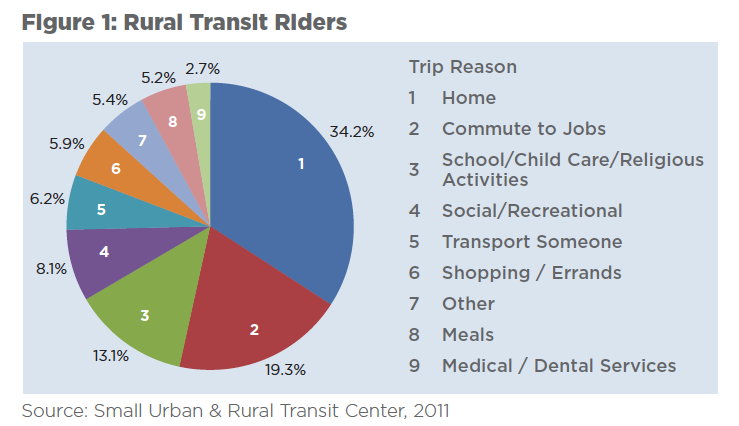RECONNECTING AMERICA
Introduction
Public transportation plays a critical and expanding role in rural America. Just as it does in urban environments, public transportation in small towns and rural areas provides mobility choices and promotes sustainable economies. Across the country, small towns and rural communities are developing partnerships to build intermodal transit centers, creating circulator buses to catalyze private investments in their downtowns, and improving connections between people and jobs. Small towns are using public transportation investments to help address the challenges of limited resources, populations both shrinking and growing older, industrial decline, and the loss of farmland. Through strong partnerships and creative funding mechanisms, rural America is creating stronger and healthier communities through transit investments. Connie Garber, a passionate advocate of rural services and transportation director at York County Community Action Corporation in Maine, sums up the motivation of rural transportation leaders: “We all are headed for the same goal: a more robust economy that helps all of the people in the communities we serve.”
In this report, the researchers have explored how smaller cities, towns, and rural places are integrating transit into their communities. This report seeks to elevate the emerging best practices in smaller cities and rural places where transit investments are helping to set the stage for a robust future. This report is intended to help local planners, elected leaders, and policymakers understand the strategies, partnerships, resources, and plans being
enacted in comparable communities across the country.
Key research questions include:
- What types of transit investments are smaller communities making?
- What impact has transit had on the economy and quality of life of those smaller communities?
- Has transit affected the historic character that exists in many of America’s small towns, or has it been integrated seamlessly into the community?
- Can a modest or incremental approach to transit investment yield results, or do only large-scale, urban-style systems yield benefits?
- How do different players influence the process?
- What is the role of the federal government in small-town transit projects?
When examining transportation investments in small towns and rural places, it is important to keep in mind the unique mobility challenges such areas face. Many rural places have long distances between destinations, and small-town residents often must travel a long way to reach specialized services or venues in larger towns and cities. The rural population in America is older than in urban areas, and older Americans experience more mobility challenges as their ability to drive decreases. As intercity bus and rail access has declined over the last several decades, small towns and rural places have become increasingly isolated from larger population centers.2 The cost of transportation for Americans living in such communities is high, and household budgets are tied to the cost of gasoline for the family car, the primary – and in many cases only – means of getting around.
These factors suggest that small towns and rural areas would benefit from transportation alternatives. But it is also clear that transit in these communities cannot look like the transit systems of larger cities. Historic low-density land-use patterns in rural areas make designing and operating transit service more challenging. Local resources to support transit planning and service are limited, and small-town residents may feel that while transit can be wonderful in a big city, it just isn’t something that would fit in with their lifestyle.
A Quick Snapshot of Rural America
Approximately 71 million Americans live in rural areas.4 Compared to urban areas, rural areas are less ethnically diverse, older, and have higher rates of home ownership and vehicle ownership.5
Today’s rural residents are more likely to engage in a wide variety of nonfarming and manufacturing activities, requiring them to drive more than in previous generations, and to cover greater distances than their urban counterparts. Compared to urban areas, rural areas in general also lack transportation options, requiring rural residents to depend more on their cars.
Still, more than 1.6 million rural households do not own cars (especially in the South, Appalachia, Southwest and Alaska).6 Nearly 40 percent of the country’s transit dependent population – primarily senior citizens, persons with disabilities and low income individuals – live in rural areas.7 Approximately 14 percent of residents in rural areas are 65 or older, higher than in urban areas (12.5 percent). About 13 percent of rural residents have a disability (9.7 million residents), and 12.3 percent are living below the poverty line (9.1 million residents).8 Public transportation is increasingly being used in small towns and rural areas to address the unique mobility challenges of the transit-dependent population in these areas.
Download full version (PDF): “Putting Transit to Work in Main Stree tAmerica”
“About Reconnecting America”
http://www.reconnectingamerica.org/
“Reconnecting America is a national nonprofit that advises civic and community leaders on how to overcome community development challenges to create better communities for all. Reconnecting America develops research and innovative public policy, while also building on-the-ground partnerships and convening players needed to accelerate decision-making.
The community where we live holds a special place in our hearts. Some of us still live in the same neighborhood where our family has had roots for generations. Some of us choose a community with an eye toward a new beginning. Where we live matters.“
Tags: communities, Reconnecting America, Rural, small town, transit investment, urban







 RSS Feed
RSS Feed